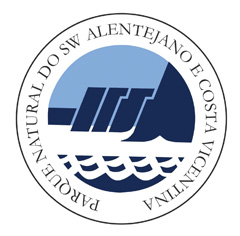Presentation
-
Sudoeste Alentejano e Costa Vicentina Nature Park (Alentejo's South West and Vicentina coast) (89.595 ha, of which 28965 ha of maritime area) has a great diversity of coastal habitats, including beaches, cliffs, islets and isolated rocks. The Pessegueiro island, in reality a consolidated dune, is anchored two steps from shore. In land, woods and moors alternate with irrigated and rainfed plantations and production woods. Presence of rare botanical species mainly on the area of the Sagres and São Vicente capes. Varied nesting bird fauna with the white stork building nests on coastal rocks and an important passageway for numerous other birds. Interesting otter population which frequents the sea. The constant presence of the ocean and never ending horizons, the majestic nature of São Vicente, a sunset of the gods, the stories of Sagres and above all those enormous stone walls posted before the ocean hiding or revealing small big beaches and attractive little fishing ports complete one of the simultaneously loneliest and most attractive landscape in Portugal.
-
Instituto da Conservação da Natureza e das Florestas, I.P. (ICNF, I.P.)
-
Cliffs and beaches
-
Algarve
-
Aljezur
Odemira
Sines
Vila do Bispo
Identification and Access
-
Access coming from:
- Sines heading towards Porto Covo follow the IC4/N120-4 and the M554, to São Torpes beach;
- Odemira, follow the N393 towards Vila Nova de Milfontes or the N120 heading towards São Teotónio;
- Lagos, you will enter the nature park heading following the N125 towards Vila do Bispo/Sagres.
-
Yes
Tip
-
In Sudoeste Alentejano e Costa Vicentina Nature Park are all those pictures you see in magazines and sometimes forget that lay right next door. The omnipresent Ocean has allied with the cliffs and beaches and the result is the "South West". The storks, confused, nest in maritime rocks and the otters swim at sea!
To observe the fauna leave early in the morning or a bit before dusk. Bring binoculars and a camera, if you have them. Always pay attention to the weather forecast and avoid performing activities in days of rain, thunderstorm or fog. Avoid going out by yourself, but, if you do, inform an acquaintance or a local entity of your departure and return. Use simple and comfortable clothes. If you wish to take long walks make outerwear, food, water, sunscreen and/or a raincoat available. You may also want to take a cellphone and flashlight (do not start a fire and don't dispose of cigarette butts incorrectly). If you want to enjoy the beaches do not forget your bathing suit. Take special precautions when walking in moist and rocky areas, to avoid falling and do not act in a way that might endanger yourself or others. In case of an accident contact the emergency service 112.
Supports in place
-
The Park has directional and informative signage throughout all of its area.
-
No
-
No
Statutes of Conservation
-
PTCON0012 Costa Sudoeste (Southwest Coast)
PTZPE0015 Costa Sudoeste (Southwest Coast)
-
Sagres Biogenetic Reserve.
near you
-

Climb Fóia, highest elevation point of Algarve, situated in the hills of Monchique, the 902 meters above sea level, from where you can watch the western part of Algarve.
Weather Conditions
What you can do
1. Find the white stork nesting on the rocks and sea cliffs (unique in the world).
2. Stroll along the coastal area, while the vegetation recovers from the winter. Watch southwest changing colors.
3. The red-billed chough, a protected species, build its nests in cracks and inaccessible holes in cliffs, and feeds in areas with low vegetation and meadows. The surrounding area to St. Vincent Cape is one of the best places to see this species in Portugal throughout the year.
4. Throughout the year there is the possibility to observe several species of cetaceans, sharks, turtles, sunfish and many seabirds’ species.
1. Take a leap to Pessegueiro island, near Porto Covo, recalling the famous Rui Veloso song (Porto Covo) from the 80s.
2. Find a succession of small enchanting beaches that will always be remembered.
3. Begin your journey in Sines at the festival Músicas do Mundo (World Music) (July).
4. In mid-August go to parties in honor of Nossa Senhora da Graça (Our Lady of Grace) - Patroness of Sagres - and watch the sea procession to Cape St. Vincent.
5. Throughout the year there is the possibility to observe several species of cetaceans, sharks, turtles, sunfish and many seabirds’ species.
1. At the beginning of October and like the birds, migrate to Sagres peninsula (the main migratory corridor in Portugal) to observe the post-nuptial migration of more than 30 species of birds (national and international rarities). Participate in the "Sagres Birdwatching Festival", where several companies and organizations organize many activities in nature.
2. Scroll to the quiet mouth of the river Mira in Milfontes and enjoy the sunset.
3. Throughout the year there is the possibility to observe several species of cetaceans, sharks, turtles, sunfish and many seabirds’ species.
4. The red-billed chough, a protected species, build their nests in cracks and inaccessible cliffs of holes, feeding in areas with low vegetation and meadows. The surrounding area to St. Vincent Cable is one of the best places to observe this species in Portugal throughout the year.
5. Go surfing in the southwest coast.
1. Wear waterproof and warm clothing, and on the Ponta de Sagres or in Cape St. Vincent, watch the show given by rough sea conditions
2. Breathe the sea breezes in a lost place - the Sardão Cape - and watch the fight between the sea and the seashore geological layers.
Best Season: All year long
Parque Natural do Sudoeste Alentejano e Costa Vicentina (Headquarters)
Rua Serpa Pinto, 32
7630-174 ODEMIRA
Telephone: (00351) 283 322 735
E-mail: pnsacv@icnf.pt







